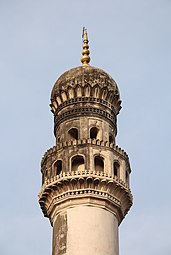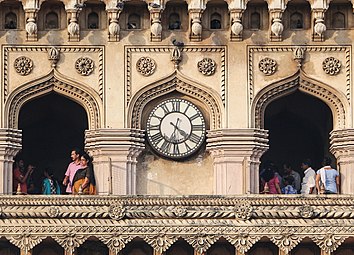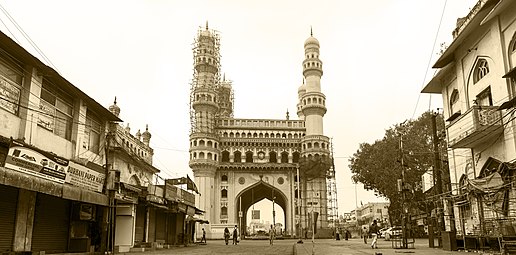Charminar
| Charminar | |
|---|---|
 | |
| Religion | |
| Affiliation | Islam |
| Location | |
| Location | Hyderabad, Telangana, India 17°21′42″N 78°28′29″E / 17.36163°N 78.47467°E / 17.36163; 78.47467Coordinates: 17°21′42″N 78°28′29″E / 17.36163°N 78.47467°E / 17.36163; 78.47467 |
| State | Telangana |
| Architecture | |
| Architect(s) | Mir Momin Astarawadi[1][2] |
| Architectural style | Indo-Islamic architecture |
| Founder | Muhammad Quli Qutb Shah |
| Specifications | |
Minaret(s) | 4 |
| Minaret height | 48.7 metres (160 ft) |
| Materials | granite, limestone, mortar and pulverized marble |
The Charminar ("Four Minarets"), constructed in 1591, is a monument and mosque located in Hyderabad, Telangana, India. The landmark has become a global icon of Hyderabad, listed among the most recognized structures of India. Charminar has been a historical place with Mosque on the top floor for over 400 years and also known for its surrounding markets. It is one of the tourist attractions in Hyderabad. It is where many famous festivals are celebrated, such as Eid-ul-adha and Eid-ul-fitr.[3]
The Charminar is situated on the east bank of Musi river.[4] To the west lies the Laad Bazaar, and to the southwest lies the richly ornamented granite Makkah Masjid.[5] It is listed as an archaeological and architectural treasure on the official "List of Monuments" prepared by the Archaeological Survey of India.[6] The English name is a translation and combination of the Urdu words Chār and Minar or meenar, translating to "Four Pillars"; the eponymous towers are ornate minarets attached and supported by four grand arches.[5]
Contents
1 History
2 Structure
3 Surrounding Area
3.1 Makkah Masjid
3.2 Bazaars
3.3 Char Kaman and Gulzar Houz
4 Influences
5 Pedestrianization Project
6 UNESCO World Heritage Site-Tentative List
7 Temple Structure
8 See also
9 References
10 External links
History

Charminar during repair works - August 2016
The fifth ruler of the Qutb Shahi dynasty, Muhammad Quli Qutb Shah, built the Charminar in 1591 after shifting his capital from Golkonda to the newly formed city of Hyderabad.

Charminar, Char Kaman and Gulzar Houz, photographed by Lala Deen Dayal in the 1880s
The Archaeological Survey of India (ASI), the current caretaker of the structure, mentions in its records, "There are various theories regarding the purpose for which Charminar was constructed. However, it is widely accepted that Charminar was built at the center of the city, to commemorate the eradication of Cholera", a deadly disease which was wide spread at that time.[7]Muhammad Quli Qutb Shah had prayed for the end of the plague that was ravaging his city and vowed to build a Mosque at the very place where he prayed.[8] According to Jean de Thévenot, a French traveller of the 17th century whose narration was complemented with the available Persian texts, the Charminar was constructed in the year 1591 CE, to commemorate the beginning of the second Islamic millennium year (1000 AH). The event was celebrated far and wide in the Islamic world, thus Qutb Shah founded the city of Hyderabad to celebrate the event and commemorate it with the construction of this building.[9][10]:17–19Due to its architecture it is also called as Arc de Triomphe of the east.[11]
The Charminar was constructed at the intersection of the historical trade route that connects the markets of Golkonda with the port city of Machilipatnam.[12]:195 The Old City of Hyderabad was designed with Charminar as its centerpiece.[13] The city was spread around the Charminar in four different quadrants and chambers, segregated according to the established settlements. Towards the north of Charminar is the Char Kaman, or four gateways, constructed in the cardinal direction.[9][12][14][15]:170 Additional eminent architects from Persia were also invited to develop the city plan. The structure itself was intended to serve as a Mosque and Madarsa. It is of Indo-Islamic architecture style, incorporating Persian architectural elements.
Historian Masud Hussain Khan says that the construction of Charminar was completed in the year 1592, and that it is the city of Hyderabad which was actually founded in the year 1591.[16]:4 According to the book "Days of the Beloved", Qutb shah constructed the Charminar in the year 1589, on the very spot where he first glimpsed his future queen Bhagmati, and after her conversion to Islam, Qutb Shah renamed the city as "Hyderabad". Though the story was rejected by the historians and scholars, it became popular folklore among the locals.[17]:3,12
Qutb Shah was also among the early poets of Dakhani Urdu. While laying the foundation of Charminar, he performed the prayers in Dakhini couplets, which are recorded as follows:[16]:4[18]
Dakhini Urdu |
|
|
During the Mughal governorship between Qutb Shahi and Asaf Jahi rule, the southwestern minaret "fell to pieces" after being struck by lightning and was repaired at a cost of Rs. 60,000.[19] In 1824, the monument was replastered at a cost of Rs. One lakh.[19]
Structure

A minaret of the Charminar

Details

Clock of the Charminar

Interior

Mosque on Second Floor

Charminar
The Charminar masjid is a square structure with each side 20 meters (approximately 66 feet) long, with four grand arches each facing a fundamental point that open into four streets. At each corner stands an exquisitely shaped minaret, 56 meters (approximately 184 feet) high, with a double balcony. Each minaret is crowned by a bulbous dome with dainty petal-like designs at the base. Unlike the minarets of Taj Mahal, Charminar's four fluted minarets are built into the main structure. There are 149 winding steps to reach the upper floor. The structure is also known for its profusion of stucco decorations and the arrangement of its balustrades and balconies.[20]
The structure is made of granite, limestone, mortar and pulverized marble and it weighs approximately 14000 tones.[21] Initially the monument with its four arches was so proportionately planned that when the fort was opened one could catch a glimpse of the bustling Hyderabad city, as these Charminar arches were facing the most active royal ancestral streets.
There is also a legend of an underground tunnel connecting the Golconda fort to Charminar, possibly intended as an escape route for the Qutb Shahi rulers in case of a siege, though the location of the tunnel is unknown.[22]
A mosque is located at the western end of the open roof; remaining part of the roof served as a court during the Qutb Shahi times. The actual mosque occupies the top floor of the four-storey structure. A vault which appears from inside like a dome supports two galleries within the Charminar, one over another, and above those a terrace that serves as a roof, bordered with a stone balcony. The main gallery has 45 covered prayer spaces with a large open space in front to accommodate more people for Friday prayers.
The clock on the four cardinal directions was added in 1889. There is a vazu (water cistern) in the middle, with a small fountain for ablution before offering prayer in the Charminar mosque.[23]
Surrounding Area

Panorama of Charminar complex, showing the Charminar, Mecca Masjid and Nizamia Hospital
The area surrounding Charminar is also known by the same name. It falls under the Charminar constituency.
Makkah Masjid
The monument overlooks another grand mosque called the Makkah Masjid. Muhammad Quli Qutb Shah, the 5th ruler of the Qutb Shahi dynasty, commissioned bricks to be made from the soil brought from Mecca, the holiest site of Islam, and used them in the construction of the central arch of the mosque, hence its name.
Bazaars

Char Kaman seen from the top of the Charminar.
A market exists around Charminar. Lad Bazaar is known for its jewelry, especially bangles, and the Pathar Gatti, which is known for its pearls. In its heyday, the Charminar market had some 14,000 shops. The Bazaars surrounding Charminar were described in the poem "In the Bazaars of Hyderabad" by Sarojini Naidu.
Char Kaman and Gulzar Houz
Four arches to the North of Charminar are known as Char Kaman. These were built along with the Charminar in the 16th century. These are the Kali Kaman, Machli Kaman, Seher-e-Batil ki Kaman and Charminar Kaman. At the center of these arches is a fountain called the Gulzar Houz. The Char Kaman are in dire need of restoration, and protection from encroachments.[24][25]
Influences

A replica of the Charminar built in the Bahadurabad locality of Karachi, Pakistan in 2007

Five Hyderabadi Rupee note issued during Asaf Jah VII's reign
In 2007, Hyderabadi Muslims living in Pakistan constructed a small-scaled quasi replica of the Charminar at the main crossing of the Bahadurabad neighborhood in Karachi.[26]
Lindt chocolatier Adelbert Boucher created a scaled model of the Charminar out of 50 kilograms of chocolate. The model, which required three days' labour, was on display at The Westin, Hyderabad, India on 25 and 26 September 2010.[27]
The Charminar Express is an express train named after the Charminar, which runs between Hyderabad and Chennai.
The Charminar also appears on coins and banknotes of the defunct Hyderabadi Rupee, the currency of the erstwhile Hyderabad State.
As an icon of the city of Hyderabad as well as the Telangana State, the structure also appears on the Emblem of Telangana, along with the Kakatiya Kala Thoranam.[28][29]
Pedestrianization Project
The "Charminar Pedestrianization Project" was instituted by the then combined Government of Andhra Pradesh
in partnership with the Greater Hyderabad Municipal Corporation.[30] The project was initiated in 2006 with an investment of Rs 35 crore. Out of Rs.35 crore, the share of Central government funds stood at Rs 12.28 crore while the State government gave Rs 5.26 crore.[31][32] However, the project did not see the light of day due to various factors such as Telangana movement, illegal encroachments by hawkers, vehicular traffic, and illegal street vendors.[33] Later during January 2017, the new Government of Telangana introduced a 14-member French Delegation to takeover the project to assess the feasibility in developing the monument as an eco-friendly tourism and heritage destination.[34][35]
The team has inspected surrounding areas such as the Gulzar house, Macca Masjid, Lad Bazar, and Sardar Mahal. Subsequently, the project took over on a brisk pace and is expected to be completed by May 2018.[31][32][34][35]
UNESCO World Heritage Site-Tentative List
Charminar, along with the Qutb Shahi Monuments of Hyderabad: the Golconda Fort, and the Qutb Shahi Tombs, were included in the "tentative list" of UNESCO World Heritage Site. The Monument was submitted by the Permanent Delegation of India to UNESCO on September 10, 2010.[36][37]
Temple Structure
A Hindu temple named Bhagyalakshmi Temple is located at the base of Charminar. A Hindu trust manages the temple dedicated to the Goddess Lakshmi. The Archaeological Survey of India (ASI) which manages the Charminar has declared the temple structure as an unauthorised construction.[38] Hyderabad High Court has stopped any further expansion of the temple.[39] While the origin of the temple is currently disputed, the current structure that houses the idol was erected in the 1960s. In 2012, The Hindu newspaper published an old photograph showing that the temple structure never existed.[40][41] The Hindu also released a note asserting the authenticity of the photographs, and clearly stated that there was no temple structure in photos taken in 1957 and 1962. Additionally, it showed photos that provide evidence that the temple is a recent structure - a temple structure can be seen in photos taken in 1990 and 1994. Also, a temple is seen in a photograph taken in 1986 which is kept in the Aga Khan Visual Archive, MIT Libraries’ collections, United States, but not in the earlier ones.[40]
See also
- Qutb Shahi dynasty
- History of Hyderabad
- Tourist attractions in Hyderabad
- Hyderabad city
- Telangana State
References
This is mughil's f Viking kingdom of heaven
^ https://www.thehindu.com/news/cities/Hyderabad/here-sleeps-the-earliest-urban-planner/article4827466.ece
^ http://www.thehansindia.com/posts/index/Hyderabad-Tab/2016-04-05/Remembering-the-man-behind-Charminars-architecture/218943
^ "Richard Goslan travels to India - Herald Scotland"..mw-parser-output cite.citation{font-style:inherit}.mw-parser-output .citation q{quotes:"""""""'""'"}.mw-parser-output .citation .cs1-lock-free a{background:url("//upload.wikimedia.org/wikipedia/commons/thumb/6/65/Lock-green.svg/9px-Lock-green.svg.png")no-repeat;background-position:right .1em center}.mw-parser-output .citation .cs1-lock-limited a,.mw-parser-output .citation .cs1-lock-registration a{background:url("//upload.wikimedia.org/wikipedia/commons/thumb/d/d6/Lock-gray-alt-2.svg/9px-Lock-gray-alt-2.svg.png")no-repeat;background-position:right .1em center}.mw-parser-output .citation .cs1-lock-subscription a{background:url("//upload.wikimedia.org/wikipedia/commons/thumb/a/aa/Lock-red-alt-2.svg/9px-Lock-red-alt-2.svg.png")no-repeat;background-position:right .1em center}.mw-parser-output .cs1-subscription,.mw-parser-output .cs1-registration{color:#555}.mw-parser-output .cs1-subscription span,.mw-parser-output .cs1-registration span{border-bottom:1px dotted;cursor:help}.mw-parser-output .cs1-ws-icon a{background:url("//upload.wikimedia.org/wikipedia/commons/thumb/4/4c/Wikisource-logo.svg/12px-Wikisource-logo.svg.png")no-repeat;background-position:right .1em center}.mw-parser-output code.cs1-code{color:inherit;background:inherit;border:inherit;padding:inherit}.mw-parser-output .cs1-hidden-error{display:none;font-size:100%}.mw-parser-output .cs1-visible-error{font-size:100%}.mw-parser-output .cs1-maint{display:none;color:#33aa33;margin-left:0.3em}.mw-parser-output .cs1-subscription,.mw-parser-output .cs1-registration,.mw-parser-output .cs1-format{font-size:95%}.mw-parser-output .cs1-kern-left,.mw-parser-output .cs1-kern-wl-left{padding-left:0.2em}.mw-parser-output .cs1-kern-right,.mw-parser-output .cs1-kern-wl-right{padding-right:0.2em}
^ Charminar (building, Hyderabad, India), Britanni a Online Encyclopedia
^ ab Charminar: Hyderabad, Britannica Compton's Encyclopedia
^ "Alphabetical List of Monuments - Andhra Pradesh". Archaeological Survey of India. Archived from the original on 25 June 2014. Retrieved 27 August 2015.
^ "Ticketed monuments-Telangana". Archaeological Survey of India. 2011. Retrieved 19 December 2012.
^ "India: Charminar is in fact a madrasa and masjid". IRIB World Service. 18 November 2012. Archived from the original on 12 January 2013. Retrieved 23 December 2012.
^ ab "The Qutb Shahi monuments of Hyderabad-Golconda Fort, Qutb Shahi Tombs, Charminar". UNESCO World Heritage Centre. 10 September 2010. Retrieved 21 December 2012.
^ Bilgrami, Syed Ali Asgar (1992) [1924]. Landmarks of the Deccan. Asian Educational Services. ISBN 8120605438.
^ "Charminar, The Most Famous Landmark Of Hyderabad!".
^ ab Gayer, Lauren; Lynton, Christophe Jaffrelot (2011). Muslims in Indian cities: trajectories of marginalisation. Columbia University Press. ISBN 9780231800853. Retrieved 21 December 2012.
^ "Mecca Mosque". Encyclopædia Britannica. Retrieved 3 November 2011.
^ "Qutb Shahi style (mainly in and around Hyderabad city)". Government of Telangana. 2002. Archived from the original on 10 January 2013. Retrieved 21 December 2012.
^ Sardar, Marika (2007). Golkonda through time: A mirror of the evolving Deccan (Thesis). New York University. UMI Number:3269810. Retrieved 21 December 2012.
^ abcd Mohammad Quli Qutb Shah, volume 216. Sahitya Akademi. 1996. ISBN 8126002336. Retrieved 21 December 2012.
^ Lynton, Harriet Ronken (1974). Days of the beloved. Orient Longman. ISBN 0863112692. Retrieved 19 December 2012.
^ abc "Final abode of Mohd. Quli Qutb Shah and six others". Chennai, India: The Hindu. 31 May 2012. Retrieved 23 December 2012.
^ ab Ifthekhar, J.S. (31 August 2010). "Charminar minaret suffers damage due to rain". The Hindu. N. Ram. Retrieved 5 December 2015.
^ Dawn Archived 10 June 2007 at the Wayback Machine
^ Papri, Paull (9 October 2016). "Is it Charminar's 425th birthday today?". The Times of India. Retrieved 9 October 2016.
^ "Take a walk through history". The Hindu. Chennai, India. 9 February 2010.
^ "Charminar Mosque". asi.nic.in/asi_monu_tktd_ap_charminar.asp. Retrieved 24 November 2012.
^ "Char kaman in Old City faces monumental neglect - Times of India". The Times of India. Retrieved 2018-07-30.
^ "The Hindu : Glory of the gates". www.thehindu.com. Retrieved 2018-07-30.
^ M. Rafique Zakaria, Charminar in Karachi, Dawn, 22 April 2007
^ http://www.hindu.com/mp/2010/09/25/stories/2010092553140000.htm A Charminar to drool and eat
^ "Exclusive: Telangana to have unique logo". India Today. Retrieved 2018-07-30.
^ "Telangana State Emblem Looks Simple Yet Profound". The New Indian Express. Retrieved 2018-07-30.
^ http://cs.chitkara.edu.in/pdf/4_CS_M_Bari.pdf
^ ab Nanisetti, Serish (2 April 2016). "Charminar Pedestrianisation Project yet to see light of the day" – via www.thehindu.com.
^ ab "Charminar Pedestrianisation Project gathers pace". 13 November 2017.
^ Nanisetti, Serish (2 November 2017). "Charminar Pedestrianisation Project getting closer to reality now" – via www.thehindu.com.
^ ab Lieres, Bettina von; Piper, L. (8 October 2014). "Mediated Citizenship: The Informal Politics of Speaking for Citizens in the Global South". Springer – via Google Books.
^ ab "French Delegation Visits Charminar Pedestrian Project - The Siasat Daily". archive.siasat.com.
^ "The Qutb Shahi Monuments of Hyderabad Golconda Fort, Qutb Shahi Tombs, Charminar". UNESCO World Heritage Centre.
^ http://epaper.timesofindia.com/Default/Layout/Includes/EDU/ArtWin.asp?From=Archive&Source=Page&Skin=EDU&BaseHref=TOIM%2F2012%2F06%2F24&ViewMode=HTML&PageLabel=22&EntityId=Ar02201&AppName=1
^ "RTI response from ASI hosted on a website". twocircles.net. Two Circles. Retrieved 12 April 2018.
^ "Trust denies expansion of Bhagyalakshmi temple". The Times of India. 2012-11-07. Retrieved 2012-11-07.
^ ab "A note on the Charminar photograph". The Hindu. Chennai, India. 21 November 2012.
^ Srivathsan, A. (20 November 2012). "As protests roil Charminar, Hyderabad's heritage slowly vanishes". The Hindu. Chennai, India.
External links
| Wikimedia Commons has media related to Charminar. |
| Wikivoyage has a travel guide for Hyderabad. |
- Photos of Charminar on HyderabadPlanet.com
- Mushroom Minarette: An article published by Out Look India.
- complete history
- A panoramic image of Charminar along with Old City of Hyderabad, The image is published in Earth Platinum Atlacharmin





